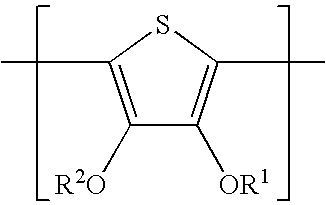Conductive polymers on acicular substrates
a technology of conductive polymers and acicular substrates, applied in the direction of non-metal conductors, cellulosic plastic layered products, conductors, etc., can solve the problems of static charging, particularly acute problems, and physical defects
- Summary
- Abstract
- Description
- Claims
- Application Information
AI Technical Summary
Benefits of technology
Problems solved by technology
Method used
Image
Examples
example a
Preparation of Electronically Conductive Particles of the Invention
[0037]25 gms of an elongated silica sol Snowtex MA-ST-UP®, supplied by Nissan Chemical, containing 20% solids in methanol is placed under agitation at room temperature under inert atmosphere. To this sol is added 0.45 gms of 3,4-ethylenedioxythiophene Baytron M®, supplied by Bayer Corporation, and agitated for one hour by which time the monomer completely mixes in the system. Subsequently, 1.50 gms of Fe (III) toluenesulfonate, Baytron C®, also supplied by Bayer Corporation at 40% solids in butanol, is added and the reaction is allowed to proceed at room temperature for 48 hours. The dispersion obtained at the end of the process comprises the electronically conductive particle of the invention.
examples 1 – 3
Examples 1–3
Coatings Comprising the Conductive Particles of the Invention
[0038]The following examples are coated with a coating rod from a dispersion similar to Example A described herein above, on cellulose triacetate film supports, with one side of the film support being previously coated with a gelatin based subbing layer. The subbing layer is typically provided on the film support for further incorporation of a photographic emulsion. The coatings of the invention are formed on either side of the film support, to demonstrate their versatility.
[0039]Durable, transparent electronically conductive coatings are formed upon drying of the coated layers. The surface electrical resistivity (SER) of these coatings are measured under different relative humidity (RH), with a Keithly Model 616 digital electrometer using a two point DC probe by a method similar to that described in U.S. Pat. No. 2,801,191, col. 4, lines 4–34.
[0040]The details of Examples 1–3 and their SER values are provided ...
PUM
| Property | Measurement | Unit |
|---|---|---|
| aspect ratio | aaaaa | aaaaa |
| length | aaaaa | aaaaa |
| thick | aaaaa | aaaaa |
Abstract
Description
Claims
Application Information
 Login to View More
Login to View More - R&D
- Intellectual Property
- Life Sciences
- Materials
- Tech Scout
- Unparalleled Data Quality
- Higher Quality Content
- 60% Fewer Hallucinations
Browse by: Latest US Patents, China's latest patents, Technical Efficacy Thesaurus, Application Domain, Technology Topic, Popular Technical Reports.
© 2025 PatSnap. All rights reserved.Legal|Privacy policy|Modern Slavery Act Transparency Statement|Sitemap|About US| Contact US: help@patsnap.com


